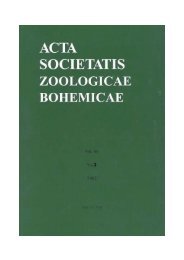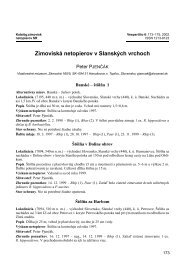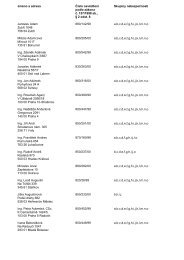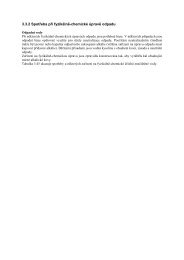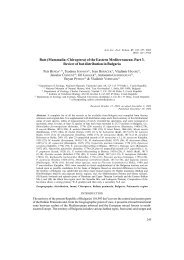Create successful ePaper yourself
Turn your PDF publications into a flip-book with our unique Google optimized e-Paper software.
Arthropods of Burgess Shale type from the Middle Cambrian of Bohemia (Czech Republic)ABFig. 8. Helmetia? fastigata sp. n. – the holotype VK42a (A) and its schematic drawing (B) supplemented by features preserved on the counterpart.Rejkovice, Ellipsocephalus hoffi – Rejkocephalus Zone. Total width 37 mm.Occurrence:The only known specimen comes fromVinice near Jince, middle part of the Jince Formation, the uppermostpart of the interval between the Eccaparadoxidespusillus and Paradoxides gracilis Zones (coll. V. Kordule).Class Artiopoda Hou et Bergström, 1997Subclass Conciliterga Hou et Bergström, 1997Order Helmetiida Novozhilov, 1969Family Helmetiidae Simonetta et Delle Cave, 1975Genus Helmetia Walcott, 1918Type species: Helmetia expansa Walcott, 1918,Burgess Shale, Middle Cambrian, British Columbia.Diagnosis: see Stormer in Harrington et al. (1959).Helmetia? fastigata sp. n.Text-fig. 8A, BHolotype: Crushed tail shield VK42a, b (with counterpart)figured in text-fig. 8A, B.Derivation of name: From Latin fastigatus =pointed (adj.).Type locality: Rejkovice near Jince, railway cutting.Type stratum: Upper part of the Jince Formation,Zone with Ellipsocephalus hoffi, level with Lindinella kordulei.Material: The holotype and two fragmentary specimenspossibly conspecific.Description. Only the tail shield is known. It is interpretedas prolonged, bearing characteristic marginalspines. The posterior, median spine is long and strong, moderatelytapering, pointed. The paired posterolateral marginalspines are markedly smaller and shorter. The posteriorpair is approached to the median spine, the next, more anterior-placedpair is poorly preserved as a still smaller projection.On one side of the shield, another longer and stouter,more anterior-placed spine is indicated and posterior-directed.However, this part of the shield is separated from themain part by a secondary fold, which makes the connectionunclear. The whole tail shield is flattened and crushed,showing secondary folds and fissures, which also form itsevidently secondary anterior delimitation.Measurements of the holotype: Sagittallength of the preserved part of the shield: 60.5 mm, widthc. 37 mm (dimensions affected by crushing), length of themedian spine 13.5 mm, length of the posterolateral spines2.5–3 mm.Remarks. Although the preservation of the holotypeis not sufficient for a full diagnosis, the configuration andposition of marginal spines on the tail shield differs fromall previously described representatives of Helmetiidaeand allows the establishment of a new species.The secondary deformations strongly affect particularlythe anterior part of the holotype. They are manifested asasymmetrical curved folds and small ridges of two kindsand dimensions: the larger curved traces of more or lesslongitudinal (exsagittal) direction strongly suggest the ichnofossiltrails Helminthopsis, the markedly smaller ridges175



